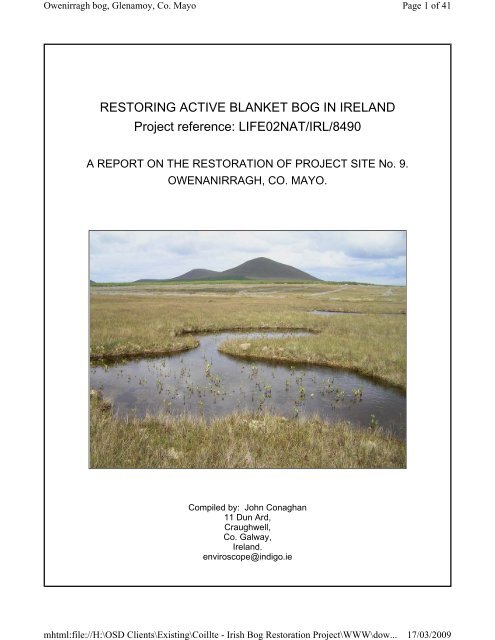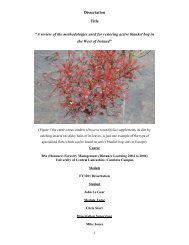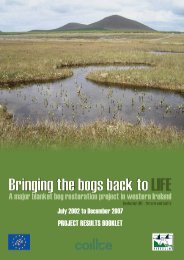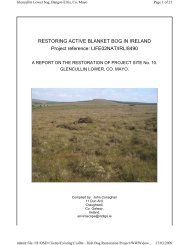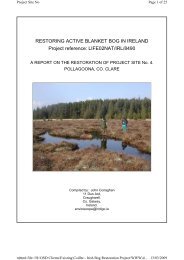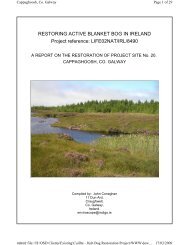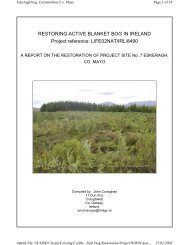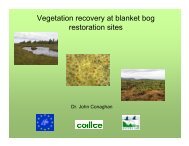Owenirragh, Glenamoy, Co. Mayo - Blanket Bog Restoration in Ireland
Owenirragh, Glenamoy, Co. Mayo - Blanket Bog Restoration in Ireland
Owenirragh, Glenamoy, Co. Mayo - Blanket Bog Restoration in Ireland
Create successful ePaper yourself
Turn your PDF publications into a flip-book with our unique Google optimized e-Paper software.
<strong>Owenirragh</strong> bog, <strong>Glenamoy</strong>, <strong>Co</strong>. <strong>Mayo</strong><br />
RESTORING ACTIVE BLANKET BOG IN IRELAND<br />
Project reference: LIFE02NAT/IRL/8490<br />
A REPORT ON THE RESTORATION OF PROJECT SITE No. 9.<br />
OWENANIRRAGH, CO. MAYO.<br />
<strong>Co</strong>mpiled by: John <strong>Co</strong>naghan<br />
11 Dun Ard,<br />
Craughwell,<br />
<strong>Co</strong>. Galway,<br />
<strong>Ireland</strong>.<br />
enviroscope@<strong>in</strong>digo.ie<br />
mhtml:file://H:\OSD Clients\Exist<strong>in</strong>g\<strong>Co</strong>illte - Irish <strong>Bog</strong> <strong>Restoration</strong> Project\WWW\dow...<br />
Page 1 of 41<br />
17/03/2009
<strong>Owenirragh</strong> bog, <strong>Glenamoy</strong>, <strong>Co</strong>. <strong>Mayo</strong><br />
mhtml:file://H:\OSD Clients\Exist<strong>in</strong>g\<strong>Co</strong>illte - Irish <strong>Bog</strong> <strong>Restoration</strong> Project\WWW\dow...<br />
Page 2 of 41<br />
17/03/2009
<strong>Owenirragh</strong> bog, <strong>Glenamoy</strong>, <strong>Co</strong>. <strong>Mayo</strong><br />
Table of contents<br />
Page No.<br />
1. Introduction 3<br />
2. Methods 4<br />
3. Site Photographs 6<br />
4. Vegetation of the Site 11<br />
5. Changes <strong>in</strong> overall vegetation/habitat cover 13<br />
6. Monitor<strong>in</strong>g quadrats 14<br />
References<br />
mhtml:file://H:\OSD Clients\Exist<strong>in</strong>g\<strong>Co</strong>illte - Irish <strong>Bog</strong> <strong>Restoration</strong> Project\WWW\dow...<br />
Page 3 of 41<br />
17/03/2009
<strong>Owenirragh</strong> bog, <strong>Glenamoy</strong>, <strong>Co</strong>. <strong>Mayo</strong><br />
Project Site No. 9 – Owenanirragh , <strong>Co</strong>. <strong>Mayo</strong><br />
1. Introduction<br />
Grid reference<br />
F 937 379<br />
SAC Name and number<br />
<strong>Glenamoy</strong> <strong>Bog</strong> <strong>Co</strong>mplex (500)<br />
Area of conifer cover (ha)<br />
107.0<br />
Elevation (m)<br />
60 to 70<br />
Site area (ha)<br />
166.0<br />
Area of open bog (ha)<br />
46.0<br />
Bedrock geology<br />
Sandstone<br />
Ma<strong>in</strong> restoration methods<br />
Fell to waste of conifer crop, w<strong>in</strong>drow<strong>in</strong>g<br />
and dra<strong>in</strong>-block<strong>in</strong>g.<br />
Area of oligotrophic lake (ha)<br />
13.0<br />
Noteworthy plant/animal species occurr<strong>in</strong>g<br />
Vacc<strong>in</strong>ium oxycoccus, Eriocaulon aquaticum, Listera cordata, Juniperus communis subsp. nana<br />
Page 4 of 41<br />
Owenanirragh is an isolated area of conifer plantation which lies 6 kilometres north-east of <strong>Glenamoy</strong><br />
village <strong>in</strong> north-west <strong>Co</strong>. <strong>Mayo</strong>. It is one of the larger sites <strong>in</strong> the project cover<strong>in</strong>g an area of 166<br />
hectares, 107 hectares of which were planted with conifers. Much of the western half of the site lies<br />
with<strong>in</strong> the <strong>Glenamoy</strong> <strong>Bog</strong> <strong>Co</strong>mplex Special Area of <strong>Co</strong>nservation which is an extensive blanket bog area<br />
with an excellent representation of blanket bog habitats.<br />
Much of the afforested portion of the site comprises relatively young conifer trees under which there still<br />
exists a bog flora, albeit modified and rather species-poor. Two ma<strong>in</strong> areas of high quality, unplanted<br />
blanket bog also occur with<strong>in</strong> the site and these conta<strong>in</strong> many well developed pool systems. The <strong>in</strong>tact<br />
bog vegetation is generally dom<strong>in</strong>ated by purple moor-grass (Mol<strong>in</strong>ia caerulea) and black bog-rush<br />
(Schoenus nigricans), while the blanket bog pools are characterised by a sparse flora which <strong>in</strong>cludes<br />
bog bean (Menyanthes trifoliata), many-stemmed spike-rush (Eleocharis multicaulis) and pipewort<br />
(Eriocaulon aquaticum). The European distribution of this latter species is conf<strong>in</strong>ed to lakes and pools <strong>in</strong><br />
lowland blanket bog areas of <strong>Ireland</strong> and western Scotland. This area of bog has also a well-developed<br />
Sphagnum cover <strong>in</strong>clud<strong>in</strong>g some large hummocks of Sphagnum imbricatum and S. fuscum. The site<br />
also conta<strong>in</strong>s a portion of Lougherglass, which is a medium–sized lowland oligotrophic lake.<br />
At this site the ma<strong>in</strong> restoration measures undertaken were the manual fell<strong>in</strong>g of the conifer crop most of<br />
which was subsequently w<strong>in</strong>d-rowed by mach<strong>in</strong>e. Any significant artificial dra<strong>in</strong>s were blocked with<br />
plastic dams.<br />
mhtml:file://H:\OSD Clients\Exist<strong>in</strong>g\<strong>Co</strong>illte - Irish <strong>Bog</strong> <strong>Restoration</strong> Project\WWW\dow...<br />
17/03/2009
<strong>Owenirragh</strong> bog, <strong>Glenamoy</strong>, <strong>Co</strong>. <strong>Mayo</strong><br />
2. Methods<br />
Prior to the start of restoration activities at the site the habitats and vegetation occurr<strong>in</strong>g were surveyed<br />
and described. Habitats occurr<strong>in</strong>g were mapped with the aid of a vertical aerial photograph of the site<br />
taken <strong>in</strong> the year 2000 by the Ordnance Survey of <strong>Ireland</strong>. At the end of the project the habitats present<br />
were mapped with the aid of a vertical aerial photograph of the site taken between 2004 and 2006.<br />
The vegetation occurr<strong>in</strong>g at the site was described us<strong>in</strong>g the Zurich-Montpellier approach (Mueller-<br />
Dombois and Ellenberg, 1979), where the percentage cover of the various vegetation layers and plant<br />
species <strong>in</strong> a def<strong>in</strong>ed area is estimated visually. The cover of plant species <strong>in</strong> relevés was estimated <strong>in</strong><br />
accordance with the Dom<strong>in</strong> scale which is outl<strong>in</strong>ed <strong>in</strong> the table below.<br />
Table 1. The Dom<strong>in</strong> scale of cover/abundance.<br />
In addition to plant species presence and cover, the follow<strong>in</strong>g parameters were noted for each relevé:<br />
(1) Size<br />
1 =
<strong>Owenirragh</strong> bog, <strong>Glenamoy</strong>, <strong>Co</strong>. <strong>Mayo</strong><br />
and local context with particular emphasis on animal species listed <strong>in</strong> Annex II of the E.U. Habitats<br />
Directive and plant species listed <strong>in</strong> the Irish Red Data Book for vascular plants (Curtis and McGough,<br />
1988), the 1999 Flora Protection Order and Annex II of the E.U. Habitats Directive.<br />
Plant species nomenclature <strong>in</strong> this report follows Stace (1997) for vascular plant, Smith (2004) for<br />
mosses, Smith (1991) for liverworts and Dahl (1968) for lichens.<br />
mhtml:file://H:\OSD Clients\Exist<strong>in</strong>g\<strong>Co</strong>illte - Irish <strong>Bog</strong> <strong>Restoration</strong> Project\WWW\dow...<br />
Page 6 of 41<br />
17/03/2009
<strong>Owenirragh</strong> bog, <strong>Glenamoy</strong>, <strong>Co</strong>. <strong>Mayo</strong><br />
3. Site Photographs<br />
In order to illustrate the restoration activities which have taken place at this site a number of photographs<br />
are presented <strong>in</strong> the follow<strong>in</strong>g pages. These <strong>in</strong>clude both aerial photographs, supplied by the Ordnance<br />
Survey of <strong>Ireland</strong>, and a selection of ground photographs taken by the author.<br />
<strong>Bog</strong> bean (Menyanthes trifoliata) is a common species of bog pools at Owenanirragh.<br />
mhtml:file://H:\OSD Clients\Exist<strong>in</strong>g\<strong>Co</strong>illte - Irish <strong>Bog</strong> <strong>Restoration</strong> Project\WWW\dow...<br />
Page 7 of 41<br />
17/03/2009
<strong>Owenirragh</strong> bog, <strong>Glenamoy</strong>, <strong>Co</strong>. <strong>Mayo</strong><br />
Page 8 of 41<br />
A view of the conifer crop at Owenanirragh viewed from the south, look<strong>in</strong>g to the north. This photograph was taken<br />
only a few weeks after the start of conifer fell<strong>in</strong>g. Photograph taken <strong>in</strong> October 2003.<br />
A photograph of the site taken from approximately the same position as above, almost 4 years after tree fell<strong>in</strong>g.<br />
Note the grey w<strong>in</strong>drows of conifers. Photograph taken <strong>in</strong> August 2007.<br />
mhtml:file://H:\OSD Clients\Exist<strong>in</strong>g\<strong>Co</strong>illte - Irish <strong>Bog</strong> <strong>Restoration</strong> Project\WWW\dow...<br />
17/03/2009
<strong>Owenirragh</strong> bog, <strong>Glenamoy</strong>, <strong>Co</strong>. <strong>Mayo</strong><br />
mhtml:file://H:\OSD Clients\Exist<strong>in</strong>g\<strong>Co</strong>illte - Irish <strong>Bog</strong> <strong>Restoration</strong> Project\WWW\dow...<br />
Page 9 of 41<br />
17/03/2009
<strong>Owenirragh</strong> bog, <strong>Glenamoy</strong>, <strong>Co</strong>. <strong>Mayo</strong><br />
Page 10 of 41<br />
In the south-western portion of this site the unplanted blanket bog conta<strong>in</strong>s a well developed system of large<br />
pools. Menyanthes trifoliata is the ma<strong>in</strong> plant species grow<strong>in</strong>g <strong>in</strong> them. Note the conifer w<strong>in</strong>d-rows <strong>in</strong> the<br />
distance. Photograph taken <strong>in</strong> August 2007.<br />
<strong>Bog</strong> pools with<strong>in</strong> this site support populations of the rare aquatic plant species Eriocaulon aquaticum. The<br />
mhtml:file://H:\OSD Clients\Exist<strong>in</strong>g\<strong>Co</strong>illte - Irish <strong>Bog</strong> <strong>Restoration</strong> Project\WWW\dow...<br />
17/03/2009
<strong>Owenirragh</strong> bog, <strong>Glenamoy</strong>, <strong>Co</strong>. <strong>Mayo</strong><br />
Page 11 of 41<br />
European distribution of this species is largely conf<strong>in</strong>ed to blanket bog pools and lakes <strong>in</strong> the west of <strong>Ireland</strong> and<br />
western Scotland.<br />
mhtml:file://H:\OSD Clients\Exist<strong>in</strong>g\<strong>Co</strong>illte - Irish <strong>Bog</strong> <strong>Restoration</strong> Project\WWW\dow...<br />
17/03/2009
<strong>Owenirragh</strong> bog, <strong>Glenamoy</strong>, <strong>Co</strong>. <strong>Mayo</strong><br />
Page 12 of 41<br />
A close-up view of w<strong>in</strong>d-rowed conifers at the site with cleared bog surface visible on the left. Photograph taken <strong>in</strong><br />
March 2004.<br />
A view of a plastic dam <strong>in</strong> a dra<strong>in</strong> at the site. Note that the water level is higher on the right hand side of the dam<br />
which shows that water is be<strong>in</strong>g reta<strong>in</strong>ed. Photograph taken <strong>in</strong> August 2007.<br />
mhtml:file://H:\OSD Clients\Exist<strong>in</strong>g\<strong>Co</strong>illte - Irish <strong>Bog</strong> <strong>Restoration</strong> Project\WWW\dow...<br />
17/03/2009
<strong>Owenirragh</strong> bog, <strong>Glenamoy</strong>, <strong>Co</strong>. <strong>Mayo</strong><br />
mhtml:file://H:\OSD Clients\Exist<strong>in</strong>g\<strong>Co</strong>illte - Irish <strong>Bog</strong> <strong>Restoration</strong> Project\WWW\dow...<br />
Page 13 of 41<br />
17/03/2009
<strong>Owenirragh</strong> bog, <strong>Glenamoy</strong>, <strong>Co</strong>. <strong>Mayo</strong><br />
An aerial photograph of the Owenanirragh site prior to restoration work tak<strong>in</strong>g place. Aerial photograph taken <strong>in</strong> the<br />
year 2000. The site is outl<strong>in</strong>ed <strong>in</strong> red. Note the areas of open bog with well-developed pool systems.<br />
2006 Aerial photograph is not available.<br />
mhtml:file://H:\OSD Clients\Exist<strong>in</strong>g\<strong>Co</strong>illte - Irish <strong>Bog</strong> <strong>Restoration</strong> Project\WWW\dow...<br />
Page 14 of 41<br />
17/03/2009
<strong>Owenirragh</strong> bog, <strong>Glenamoy</strong>, <strong>Co</strong>. <strong>Mayo</strong><br />
4. Vegetation of the site<br />
Page 15 of 41<br />
This site is dom<strong>in</strong>ated by a conifer crop which was planted <strong>in</strong> 1990. The ma<strong>in</strong> tree species planted was<br />
Sitka spruce with lodgepole p<strong>in</strong>e also planted <strong>in</strong> smaller amounts. By the start of this restoration project<br />
<strong>in</strong> 2003 these trees had not grown to the stage where the native blanket bog flora had been completely<br />
killed off. Mol<strong>in</strong>ia caerulea and Calluna vulgaris were still common <strong>in</strong> the ground layer with mosses such<br />
as Hypnum cupressiforme, Rhytidiadelphus loreus and Sphagnum capillifolium also present.<br />
A remarkable feature of this site is the occurrence of two extensive areas of unplanted blanket bog with<br />
well-developed pool systems. Menyanthes trifoliata is the ma<strong>in</strong> species <strong>in</strong> these pools with Sphagnum<br />
cuspidatum, S. auriculatum, Eriocaulon aquaticum and Eleocharis multicaulis also characteristic. The<br />
rare shrub Juniperus communis subsp. nana was noted grow<strong>in</strong>g on the larger island hummocks with<strong>in</strong><br />
blanket bog pools and also along pool marg<strong>in</strong>s. The <strong>in</strong>tact, undra<strong>in</strong>ed blanket bog vegetation itself is<br />
dom<strong>in</strong>ated by the typical blanket bog species Schoenus nigricans, Trichophorum cespitosum, Erica<br />
tetralix and Narthecium ossifragum. The composition of the bog vegetation is outl<strong>in</strong>ed <strong>in</strong> the follow<strong>in</strong>g<br />
table.<br />
Quite a well developed bog natural dra<strong>in</strong>age channel runs <strong>in</strong> a southerly direction through the middle of<br />
the site. Frequent plant species <strong>in</strong> this channel <strong>in</strong>clude Carex paniculata, Angelica sylvestris,<br />
Menyanthes trifoliata, Carex rostrata and Potentilla palustris.<br />
mhtml:file://H:\OSD Clients\Exist<strong>in</strong>g\<strong>Co</strong>illte - Irish <strong>Bog</strong> <strong>Restoration</strong> Project\WWW\dow...<br />
17/03/2009
<strong>Owenirragh</strong> bog, <strong>Glenamoy</strong>, <strong>Co</strong>. <strong>Mayo</strong><br />
Table 2. Vegetation at Owenanirragh.<br />
Page 16 of 41<br />
A A A A A B B B B B C C C C C<br />
Quadrat code 13 8 11 3 5 2 15 6 10 7 4 9 12 14 1<br />
Quadrat size (m2 )<br />
4 4 3 4 4 4 4 4 4 4 4 4 4 4 4<br />
Slope (degrees) 0 0 0 0 0 1-3 0 0 0 0 1-3 3-5 0 0 1-3<br />
Vegetation cover (%) 30 15 95 95 40 95 99 98 98 95 100 100 100 100 100<br />
Bare rock (%) 0 0 0 0 0 0 0 0 0 0 0 0 0 0 0<br />
Bare soil (%) 0 0 0 0 10 5 1 2 2 5 0 0 0 0 0<br />
Surface water (%) 100 100 0 100 70 0 0 0 0 0 0 0 0 0 0<br />
Dwarf shrub cover 0 0 0 0 0 50 40 50 45 55 40 70 60 10 40<br />
(%)<br />
Herb cover (%) 30 15 40 15 35 70 60 65 60 60 65 40 50 95 70<br />
Bryophyte cover (%) 0 0 95 95 12 70 50 60 70 40 35 50 5 15 5<br />
Ht. of vegetation 10 15 10 5 8 10 10 15 10 15 35 35 40 35 30<br />
(cm)<br />
No. of species 1 2 5 6 6 22 21 20 19 16 12 12 7 6 6<br />
Menyanthes trifoliata 6 4 5 4 . . . . . . . . . . .<br />
Eriocaulon<br />
. 5 . . . . . . . . . . . . .<br />
aquaticum<br />
Sphagnum<br />
. . 9 9 3 . . . . . . . . . .<br />
cuspidatum<br />
Eleocharis<br />
. . 5 2 5 . . . . . . . . . .<br />
multicaulis<br />
Sphagnum<br />
. . 2 4 5 . . . . . . . . . .<br />
auriculatum<br />
Schoenus nigricans . . . 1 . 3 5 5 5 5 . . . . .<br />
Narthecium<br />
. . . . . 4 4 3 4 4 . . . . .<br />
ossifragum<br />
Racomitrium<br />
. . . . . 2 5 5 5 5 . . . . .<br />
lanug<strong>in</strong>osum<br />
Sphagnum tenellum . . . . . 2 4 3 4 4 . . . . .<br />
Eriophorum<br />
. . . . . 4 5 4 4 . . . . . .<br />
vag<strong>in</strong>atum<br />
Cladonia uncialis . . . . . 3 1 4 4 . . . . . .<br />
Pleurozia purpurea . . . . . 5 5 5 5 . . . . .<br />
Odontoschisma<br />
. . . . . 2 3 3 3 . . 2 . . .<br />
sphagni<br />
Drosera rotundifolia . . . . . 2 1 1 1 . . . . . .<br />
Trichophorum<br />
. . . . . 4 3 . 2 4 . . . . .<br />
cespitosum<br />
Rhynchospora alba . . . . 1 . 3 2 . 3 . . . . .<br />
Sphagnum<br />
. . . . . 3 . . . 3 . . . . .<br />
papillosum<br />
Eriophorum<br />
. . 4 1 4 5 4 4 5 4 . . . . .<br />
angustifolium<br />
Mol<strong>in</strong>ia caerulea . . . . 3 6 6 7 7 7 8 7 7 10 8<br />
Calluna vulgaris . . . . . 5 5 5 5 6 6 8 8 3 7<br />
Potentilla erecta . . . . . 3 2 2 2 3 2 2 3 1 2<br />
Sphagnum<br />
. . . . . 7 4 4 3 4 . 5 3 4 4<br />
capillifolium<br />
Erica tetralix . . . . . 5 5 6 6 6 1 4 2 . 2<br />
Hypnum<br />
. . . . . 4 3 2 4 . 5 5 3 4 .<br />
cupressiforme<br />
Erica c<strong>in</strong>erea . . . . . 3 2 4 3 . . 5 1 4 4<br />
Cladonia portentosa . . . . . 6 6 5 7 5 4 6 . . .<br />
Polygala serpyllifolia . . . . . . . 1 . 3 . 1 . . .<br />
Pleurozium schreberi . . . . . . . . . . 3 1 . . .<br />
Carex panicea . . . . . 4 . . . . . . . . .<br />
Leucobryum glaucum . . . . . 1 . . . . . . . . .<br />
Succisa pratensis . . . . . 1 . . . . . . . . .<br />
Campylopus<br />
. . . . . . 1 . . . . . . . .<br />
atrovirens<br />
Dicranum scoparium . . . . . . . . . . 2 . . . .<br />
Dryopteris dilatata . . . . . . . . . . 2 . . . .<br />
mhtml:file://H:\OSD Clients\Exist<strong>in</strong>g\<strong>Co</strong>illte - Irish <strong>Bog</strong> <strong>Restoration</strong> Project\WWW\dow...<br />
17/03/2009
<strong>Owenirragh</strong> bog, <strong>Glenamoy</strong>, <strong>Co</strong>. <strong>Mayo</strong><br />
Rhytidiadelphus . . . . . . . . . . 2 . . . .<br />
loreus<br />
Saccogyna viticulosa . . . . . . . . . . 1 . . . .<br />
Salix aurita . . . . . . . . . . 1 . . . .<br />
Campylopus<br />
. . . . . . . . . . . 2 . . .<br />
<strong>in</strong>troflexus<br />
A = <strong>Blanket</strong> bog pools<br />
B = Intact blanket bog dom<strong>in</strong>ated by Schoenus nigricans and Mol<strong>in</strong>ia caerulea<br />
C = Dra<strong>in</strong>ed blanket bog dom<strong>in</strong>ated by Mol<strong>in</strong>ia caerulea<br />
mhtml:file://H:\OSD Clients\Exist<strong>in</strong>g\<strong>Co</strong>illte - Irish <strong>Bog</strong> <strong>Restoration</strong> Project\WWW\dow...<br />
Page 17 of 41<br />
17/03/2009
<strong>Owenirragh</strong> bog, <strong>Glenamoy</strong>, <strong>Co</strong>. <strong>Mayo</strong><br />
5. Changes <strong>in</strong> overall vegetation/habitat cover<br />
This site is now characterized by regenerat<strong>in</strong>g lowland blanket bog, dom<strong>in</strong>ated by Mol<strong>in</strong>ia caerulea, with<br />
numerous rows of felled conifers. In three small areas the trees were not w<strong>in</strong>drowed for experimental<br />
purposes and Mol<strong>in</strong>ia is also atta<strong>in</strong><strong>in</strong>g dom<strong>in</strong>ance <strong>in</strong> these. There has been little observable change <strong>in</strong><br />
the open bog areas as they were not subject to any restoration work.<br />
A map of habitat/vegetation cover at Owenanirragh prior to the start of restoration.<br />
mhtml:file://H:\OSD Clients\Exist<strong>in</strong>g\<strong>Co</strong>illte - Irish <strong>Bog</strong> <strong>Restoration</strong> Project\WWW\dow...<br />
Page 18 of 41<br />
17/03/2009
<strong>Owenirragh</strong> bog, <strong>Glenamoy</strong>, <strong>Co</strong>. <strong>Mayo</strong><br />
A map of habitat/vegetation cover at Owenanirragh prior at the end of restoration.<br />
6. Monitor<strong>in</strong>g quadrats<br />
In the follow<strong>in</strong>g pages the vegetation changes which have taken place with<strong>in</strong> the site over the period of<br />
the restoration project are shown by means of observed changes <strong>in</strong> permanent quadrats. A total of 6<br />
permanent quadrats were described and photographed. In the case of each quadrat photographs and<br />
vegetation tables are presented. In order to ensure the future relocation of quadrats the corners have<br />
been marked with short sticks and a 10-figure GPS read<strong>in</strong>g was also recorded. The cover of plant<br />
species with<strong>in</strong> the quadrats is presented <strong>in</strong> accordance with the scale outl<strong>in</strong>ed <strong>in</strong> the follow<strong>in</strong>g table.<br />
<strong>Co</strong>ver of species <strong>in</strong> quadrat <strong>Co</strong>ver <strong>in</strong> presented quadrat tables<br />
75% cover of the species <strong>in</strong> most areas with<strong>in</strong> 3<br />
years. The other ma<strong>in</strong> recoloniz<strong>in</strong>g species are Hypnum cupressiforme, Campylopus sp., Calluna<br />
mhtml:file://H:\OSD Clients\Exist<strong>in</strong>g\<strong>Co</strong>illte - Irish <strong>Bog</strong> <strong>Restoration</strong> Project\WWW\dow...<br />
17/03/2009
<strong>Owenirragh</strong> bog, <strong>Glenamoy</strong>, <strong>Co</strong>. <strong>Mayo</strong><br />
vulgaris, Sphagnum capillifolium, Polytrichum commune and Potentilla erecta.<br />
Page 20 of 41<br />
In areas of the site where a cover of taller lodgepole p<strong>in</strong>e trees was felled and w<strong>in</strong>drowed the bog<br />
vegetation was largely killed off by the deposition of a layer of p<strong>in</strong>e needles (see permanent quadrat 4<br />
and 5). Although Mol<strong>in</strong>ia is also frequent <strong>in</strong> these areas the recovery of vegetation has been slower with<br />
a high cover of disturbed peatland species, e.g. Campylopus sp., and Epilobium angustifolium, evident.<br />
mhtml:file://H:\OSD Clients\Exist<strong>in</strong>g\<strong>Co</strong>illte - Irish <strong>Bog</strong> <strong>Restoration</strong> Project\WWW\dow...<br />
17/03/2009
<strong>Owenirragh</strong> bog, <strong>Glenamoy</strong>, <strong>Co</strong>. <strong>Mayo</strong><br />
Quadrat 1 – July 2004<br />
Quadrat 1 – August 2007<br />
mhtml:file://H:\OSD Clients\Exist<strong>in</strong>g\<strong>Co</strong>illte - Irish <strong>Bog</strong> <strong>Restoration</strong> Project\WWW\dow...<br />
Page 21 of 41<br />
17/03/2009
<strong>Owenirragh</strong> bog, <strong>Glenamoy</strong>, <strong>Co</strong>. <strong>Mayo</strong><br />
mhtml:file://H:\OSD Clients\Exist<strong>in</strong>g\<strong>Co</strong>illte - Irish <strong>Bog</strong> <strong>Restoration</strong> Project\WWW\dow...<br />
Page 22 of 41<br />
17/03/2009
<strong>Owenirragh</strong> bog, <strong>Glenamoy</strong>, <strong>Co</strong>. <strong>Mayo</strong><br />
Site - Owenanirragh<br />
<strong>Co</strong>de - PQ1<br />
GPS – F 93981 37415<br />
Near Walrag? - No<br />
Size (m) – 8x8<br />
Slope (Degrees) – < 5<br />
Vegetation cover (%) 70 80 98<br />
Needle litter cover (%) 30 20 0<br />
Bare soil (%) 30 3
<strong>Owenirragh</strong> bog, <strong>Glenamoy</strong>, <strong>Co</strong>. <strong>Mayo</strong><br />
mhtml:file://H:\OSD Clients\Exist<strong>in</strong>g\<strong>Co</strong>illte - Irish <strong>Bog</strong> <strong>Restoration</strong> Project\WWW\dow...<br />
Page 24 of 41<br />
17/03/2009
<strong>Owenirragh</strong> bog, <strong>Glenamoy</strong>, <strong>Co</strong>. <strong>Mayo</strong><br />
Quadrat 2 – July 2004<br />
Quadrat 2 – August 2007<br />
mhtml:file://H:\OSD Clients\Exist<strong>in</strong>g\<strong>Co</strong>illte - Irish <strong>Bog</strong> <strong>Restoration</strong> Project\WWW\dow...<br />
Page 25 of 41<br />
17/03/2009
<strong>Owenirragh</strong> bog, <strong>Glenamoy</strong>, <strong>Co</strong>. <strong>Mayo</strong><br />
mhtml:file://H:\OSD Clients\Exist<strong>in</strong>g\<strong>Co</strong>illte - Irish <strong>Bog</strong> <strong>Restoration</strong> Project\WWW\dow...<br />
Page 26 of 41<br />
17/03/2009
<strong>Owenirragh</strong> bog, <strong>Glenamoy</strong>, <strong>Co</strong>. <strong>Mayo</strong><br />
Site - Owenanirragh<br />
<strong>Co</strong>de – PQ2<br />
GPS – F 93889 37739<br />
Near Walrag? - No<br />
Size (m) – 8x8<br />
Slope (Degrees) – < 1<br />
Vegetation cover (%) 80 95 98<br />
Needle litter cover (%) 30 10 3<br />
Bare soil (%) 5 0 0<br />
Vegetation height (cm) 30-40 40 to 50 40 to 50<br />
Dwarf shrub cover (%) 3 8 10<br />
Herb cover (%) 75 95 98<br />
Bryophyte cover (%) 30 35 50<br />
No of species present 15 18 22<br />
Date of survey 23/7/04 16/8/05 8/8/2007<br />
Mol<strong>in</strong>ia caerulea 6 7 7<br />
Hypnum cupressiforme 4 4 5<br />
Sphagnum capillifolium 3 2 3<br />
Calluna vulgaris 2 3 3<br />
Polytrichum commune 2 2 3<br />
Potentilla erecta 2 2 2<br />
Rhytidiadelphus loreus 2 1 3<br />
Agrostis sp. 1 2 2<br />
Campylopus <strong>in</strong>troflexus 1 2 3<br />
Erica tetralix 1 2 2<br />
Dryopteris dilatata 1 1 1<br />
Epilobium angustifolium 1 1 3<br />
Epilobium sp. 1 1 1<br />
Dicranum scoparium 1 - 1<br />
Leucobryum glaucum 1 - -<br />
Erica c<strong>in</strong>erea 1 1<br />
Hylocomium splendens 2 3<br />
Hypochoeris radicata 1 -<br />
Polygala serpyllifolia 1 1<br />
Rumex acetosa 1 1<br />
Rhytidiadelphus squarrosus 3<br />
Eurhynchium praelongum 3<br />
Angelica sylvestris 1<br />
Cladonia sp. 1<br />
History – Previously dom<strong>in</strong>ated by a young Sitka spruce plantation planted <strong>in</strong><br />
1990. Trees were generally between 4 and 7 metres tall. Ground<br />
vegetation was dom<strong>in</strong>ated by a sparse growth of purple moor grass and<br />
scattered mosses (ma<strong>in</strong>ly Hypnum cupressiforme). Trees felled to waste<br />
<strong>in</strong> early 2004.<br />
mhtml:file://H:\OSD Clients\Exist<strong>in</strong>g\<strong>Co</strong>illte - Irish <strong>Bog</strong> <strong>Restoration</strong> Project\WWW\dow...<br />
Page 27 of 41<br />
17/03/2009
<strong>Owenirragh</strong> bog, <strong>Glenamoy</strong>, <strong>Co</strong>. <strong>Mayo</strong><br />
mhtml:file://H:\OSD Clients\Exist<strong>in</strong>g\<strong>Co</strong>illte - Irish <strong>Bog</strong> <strong>Restoration</strong> Project\WWW\dow...<br />
Page 28 of 41<br />
17/03/2009
<strong>Owenirragh</strong> bog, <strong>Glenamoy</strong>, <strong>Co</strong>. <strong>Mayo</strong><br />
Quadrat 3 – July 2004<br />
Quadrat 3 – August 2007<br />
mhtml:file://H:\OSD Clients\Exist<strong>in</strong>g\<strong>Co</strong>illte - Irish <strong>Bog</strong> <strong>Restoration</strong> Project\WWW\dow...<br />
Page 29 of 41<br />
17/03/2009
<strong>Owenirragh</strong> bog, <strong>Glenamoy</strong>, <strong>Co</strong>. <strong>Mayo</strong><br />
mhtml:file://H:\OSD Clients\Exist<strong>in</strong>g\<strong>Co</strong>illte - Irish <strong>Bog</strong> <strong>Restoration</strong> Project\WWW\dow...<br />
Page 30 of 41<br />
17/03/2009
<strong>Owenirragh</strong> bog, <strong>Glenamoy</strong>, <strong>Co</strong>. <strong>Mayo</strong><br />
Site - Owenanirragh<br />
<strong>Co</strong>de – PQ3<br />
GPS – F 93852 38066<br />
Near Walrag? - No<br />
Size (m) – 8x8<br />
Slope (Degrees) – 0<br />
Vegetation cover (%) 98 100 100<br />
Needle litter cover (%) 0 0 0<br />
Cut stumps (%) 2 0 0<br />
Vegetation height (cm) 40-50 40-50 40 to 60<br />
Dwarf shrub cover (%) 60 60 50<br />
Herb cover (%) 40 40 45<br />
Bryophyte cover (%) 20 25 30<br />
No of species present 9 9 8<br />
Date of survey 23/7/04 16/8/05 8/8/2007<br />
Calluna vulgaris 6 6 6<br />
Mol<strong>in</strong>ia caerulea 5 5 5<br />
Hypnum cupressiforme 4 4 4<br />
Sphagnum capillifolium 2 3 3<br />
Rhytidiadelphus loreus 2 2 2<br />
Potentilla erecta 1 2 2<br />
Cladonia portentosa 1 1 -<br />
Erica tetralix 1 1 -<br />
Aulocomium palustris - 1 -<br />
Dicranum scoparium 1 - -<br />
Pleurozium schreberi 1<br />
Liverwort species 1<br />
History – Previously dom<strong>in</strong>ated by a young Sitka spruce plantation planted <strong>in</strong><br />
1990. Trees were generally between 4 and 7 metres tall. Ground<br />
vegetation was dom<strong>in</strong>ated by heather and purple moor grass. Trees felled<br />
to waste <strong>in</strong> early 2004.<br />
mhtml:file://H:\OSD Clients\Exist<strong>in</strong>g\<strong>Co</strong>illte - Irish <strong>Bog</strong> <strong>Restoration</strong> Project\WWW\dow...<br />
Page 31 of 41<br />
17/03/2009
<strong>Owenirragh</strong> bog, <strong>Glenamoy</strong>, <strong>Co</strong>. <strong>Mayo</strong><br />
Quadrat 4 – July 2004<br />
Quadrat 4 – August 2007<br />
mhtml:file://H:\OSD Clients\Exist<strong>in</strong>g\<strong>Co</strong>illte - Irish <strong>Bog</strong> <strong>Restoration</strong> Project\WWW\dow...<br />
Page 32 of 41<br />
17/03/2009
<strong>Owenirragh</strong> bog, <strong>Glenamoy</strong>, <strong>Co</strong>. <strong>Mayo</strong><br />
mhtml:file://H:\OSD Clients\Exist<strong>in</strong>g\<strong>Co</strong>illte - Irish <strong>Bog</strong> <strong>Restoration</strong> Project\WWW\dow...<br />
Page 33 of 41<br />
17/03/2009
<strong>Owenirragh</strong> bog, <strong>Glenamoy</strong>, <strong>Co</strong>. <strong>Mayo</strong><br />
Site - Owenanirragh<br />
<strong>Co</strong>de – PQ4<br />
GPS – F 93460 38014<br />
Near Walrag? - No<br />
Size (m) – 8x8<br />
Slope (Degrees) – < 5<br />
Vegetation cover (%) 15 60 90<br />
Needle litter cover (%) 90 40 10<br />
Bare soil (%) 5 3 3<br />
Vegetation height (cm)
<strong>Owenirragh</strong> bog, <strong>Glenamoy</strong>, <strong>Co</strong>. <strong>Mayo</strong><br />
mhtml:file://H:\OSD Clients\Exist<strong>in</strong>g\<strong>Co</strong>illte - Irish <strong>Bog</strong> <strong>Restoration</strong> Project\WWW\dow...<br />
Page 35 of 41<br />
17/03/2009
<strong>Owenirragh</strong> bog, <strong>Glenamoy</strong>, <strong>Co</strong>. <strong>Mayo</strong><br />
Quadrat 5 – July 2004<br />
mhtml:file://H:\OSD Clients\Exist<strong>in</strong>g\<strong>Co</strong>illte - Irish <strong>Bog</strong> <strong>Restoration</strong> Project\WWW\dow...<br />
Page 36 of 41<br />
17/03/2009
<strong>Owenirragh</strong> bog, <strong>Glenamoy</strong>, <strong>Co</strong>. <strong>Mayo</strong><br />
Quadrat 5 – August 2007<br />
mhtml:file://H:\OSD Clients\Exist<strong>in</strong>g\<strong>Co</strong>illte - Irish <strong>Bog</strong> <strong>Restoration</strong> Project\WWW\dow...<br />
Page 37 of 41<br />
17/03/2009
<strong>Owenirragh</strong> bog, <strong>Glenamoy</strong>, <strong>Co</strong>. <strong>Mayo</strong><br />
Site - Owenanirragh<br />
<strong>Co</strong>de – PQ5<br />
GPS – F 93039 37750<br />
Near Walrag? - No<br />
Size (m) – 8x8<br />
Slope (Degrees) – 5 to 15<br />
Vegetation cover (%) 5 35 70<br />
Needle litter cover (%) 95 70 30<br />
Bare soil (%) 3 2 2<br />
Vegetation height (cm)
<strong>Owenirragh</strong> bog, <strong>Glenamoy</strong>, <strong>Co</strong>. <strong>Mayo</strong><br />
Quadrat 6 – July 2004<br />
Quadrat 7 – August 2007<br />
mhtml:file://H:\OSD Clients\Exist<strong>in</strong>g\<strong>Co</strong>illte - Irish <strong>Bog</strong> <strong>Restoration</strong> Project\WWW\dow...<br />
Page 39 of 41<br />
17/03/2009
<strong>Owenirragh</strong> bog, <strong>Glenamoy</strong>, <strong>Co</strong>. <strong>Mayo</strong><br />
Page 40 of 41<br />
Area with heavy cover of lodgepole p<strong>in</strong>e felled <strong>in</strong> 2004. No permanent quadrat recorded. Note<br />
breakdown of conifers and emergent Mol<strong>in</strong>ia caerulea.<br />
mhtml:file://H:\OSD Clients\Exist<strong>in</strong>g\<strong>Co</strong>illte - Irish <strong>Bog</strong> <strong>Restoration</strong> Project\WWW\dow...<br />
17/03/2009
<strong>Owenirragh</strong> bog, <strong>Glenamoy</strong>, <strong>Co</strong>. <strong>Mayo</strong><br />
REFERENCES<br />
Curtis, T.G.F. & McGough, H.N. (1988). The Irish Red Data Book. 1: Vascular Plants. The Stationery<br />
Office, Dubl<strong>in</strong>.<br />
Dahl, E. (1968). Analytical Key to British Macrolichens (2 nd ed.). British Lichen Society, London.<br />
Mueller-Dombois, D. & Ellenberg, H. (1974). Aims and Methods <strong>in</strong> Vegetation Ecology. Wiley, New<br />
York.<br />
Smith, A.J.E. (2004). The Moss Flora of Brita<strong>in</strong> and <strong>Ireland</strong> (2 nd edition). University Press, Cambridge.<br />
Smith, A.J.E. (1990). The Liverworts of Brita<strong>in</strong> and <strong>Ireland</strong>. University Press, Cambridge.<br />
Stace, C. (1997). New Flora of the British Isles (2 nd edition). University Press, Cambridge.<br />
mhtml:file://H:\OSD Clients\Exist<strong>in</strong>g\<strong>Co</strong>illte - Irish <strong>Bog</strong> <strong>Restoration</strong> Project\WWW\dow...<br />
Page 41 of 41<br />
17/03/2009


